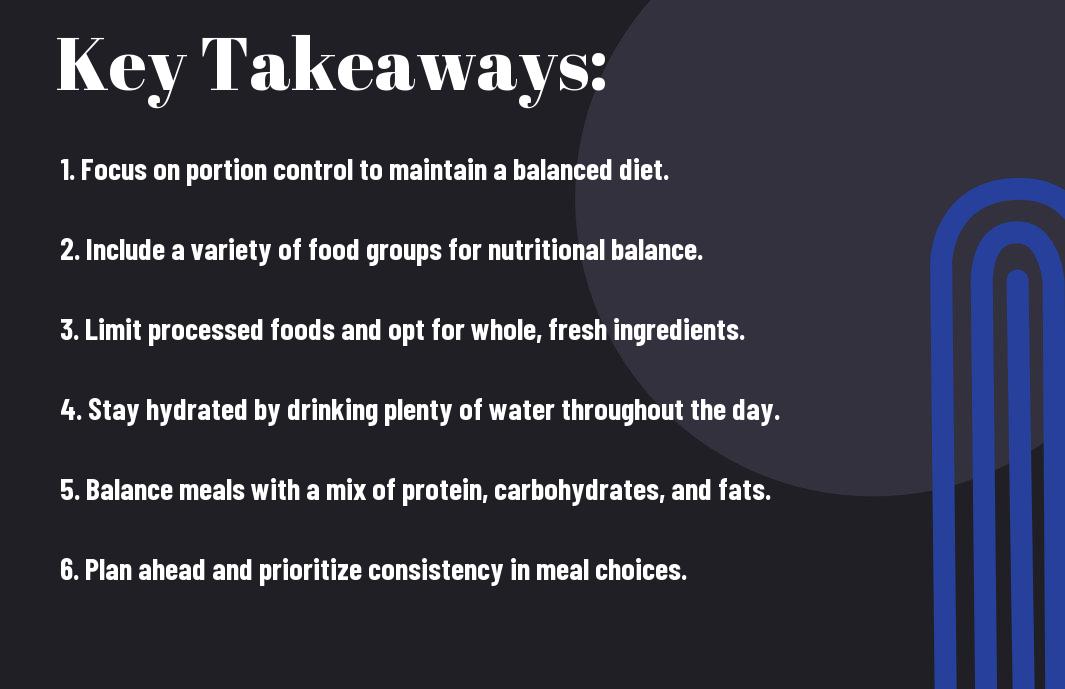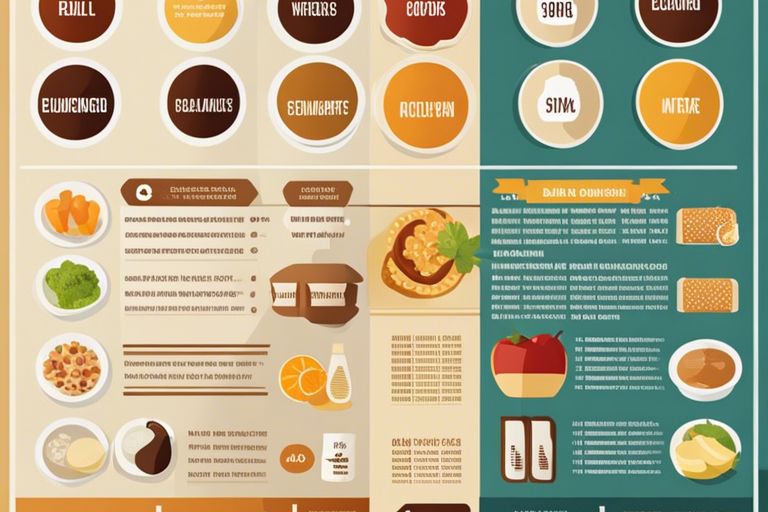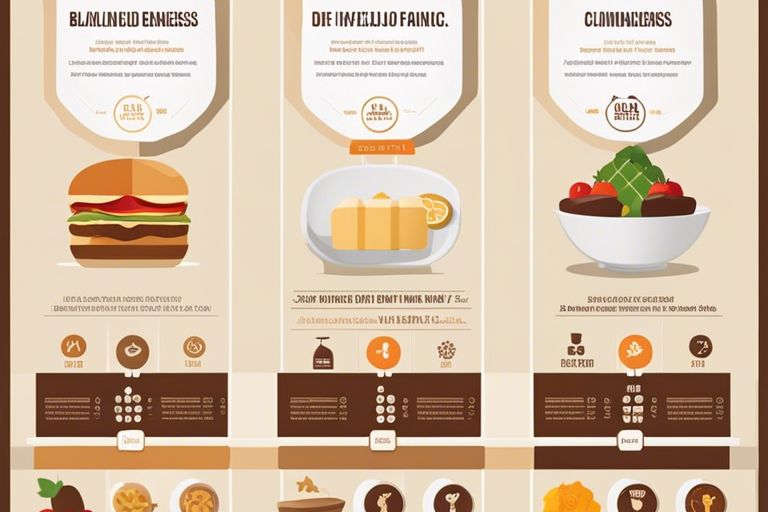Blandness in the diet often gets a bad reputation, but when utilized correctly, it can be the key to achieving a healthy and balanced lifestyle. This comprehensive diet chart focuses on the benefits of incorporating simple, unseasoned foods into your daily meals. By understanding the importance of moderation and nutrient-rich options, you can improve your overall well-being and avoid the dangers of excessive processed foods. Let’s examine into the world of balanced blandness and learn how it can transform your relationship with food.

Table of Contents
Understanding Nutritional Balance
Macronutrients and Their Roles
With a balanced diet, it is vital to understand the role of macronutrients that provide the necessary energy for bodily functions. Macronutrients include carbohydrates, proteins, and fats. Carbohydrates are the body’s primary source of energy, proteins are vital for tissue repair and muscle growth, and fats help in nutrient absorption and hormone production.
The Function of Micronutrients
Their micronutrients are equally important as they are required in smaller quantities but play a critical role in various metabolic processes. Vitamins and minerals are micronutrients that support immune function, bone health, and overall well-being. It is crucial to consume a variety of foods to ensure an adequate intake of these vital micronutrients.
This means incorporating a diverse range of fruits, vegetables, whole grains, lean proteins, and healthy fats into your diet. Micronutrients like vitamin C, vitamin D, calcium, and iron are especially crucial for maintaining optimal health. Deficiencies in these micronutrients can lead to serious health complications, making it vital to prioritize a well-rounded diet.
Creating a Bland Diet Chart
Identifying Bland Foods
If you are looking to commence on a bland diet, it is important to start by identifying bland foods. These are foods that are not overly flavorful or spicy, such as plain rice, boiled chicken, steamed vegetables, and unseasoned tofu. These foods are gentle on the digestive system and can help alleviate gastrointestinal issues.
Structuring Meals and Snacks
On a bland diet, structuring meals and snacks is key to maintaining a well-balanced and satisfying eating plan. Start by incorporating a combination of protein sources such as lean meats, fish, and legumes, along with complex carbohydrates like whole grains and starchy vegetables. Be sure to include fiber-rich foods like fruits and vegetables to promote healthy digestion.
Foods
When planning meals and snacks on a bland diet, consider the portion sizes and the frequency of meals throughout the day. Eating smaller, frequent meals can help keep blood sugar levels stable and prevent overeating. Additionally, make sure to drink plenty of water throughout the day to stay hydrated and aid digestion.
Benefits and Challenges
Health Benefits of a Bland Diet
One of the key benefits of a bland diet is its gentle nature on the digestive system. Bland foods are easier to digest, making them ideal for individuals with digestive issues such as acid reflux, gastritis, or inflammatory bowel disease. This diet can help alleviate symptoms like bloating, gas, and stomach discomfort, promoting better gastrointestinal health.
Overcoming the Challenges of Dietary Blandness
The biggest challenge of following a bland diet is the perceived lack of flavor and variety. However, this can be overcome by using herbs, spices, and other flavor-boosting ingredients that are gentle on the stomach. The key is to get creative with your cooking and experiment with different combinations to enhance the taste of bland foods without compromising their digestibility.
Benefits: Embracing a bland diet can have significant benefits for individuals struggling with digestive issues. By opting for gentle, easy-to-digest foods, they can experience relief from common gastrointestinal symptoms and promote overall digestive health.

Adapting the Diet Chart to Lifestyle
Customizing for Dietary Restrictions
Restrictions – When adapting the diet chart to accommodate dietary restrictions, it is necessary to identify the specific needs of individuals. Whether it be allergies, intolerances, or personal preferences, customization is key. Substitute ingredients, alter portion sizes, or seek professional advice to ensure a balanced and bland diet plan that suits your unique requirements.
Incorporating Blandness in Various Cuisines
Adapting – Incorporating blandness does not mean sacrificing flavor. It is about using herbs, spices, and cooking methods creatively to enhance the taste of dishes while maintaining a balanced diet. Consider experimenting with different cuisines such as Asian, Mediterranean, or Mexican, and learn how to infuse them with subtle flavors that align with your bland eating goals.
Lifestyle – Integrating blandness into various cuisines can elevate your eating experience and prevent monotony in your diet. By exploring diverse cooking styles and ingredients, you can cultivate a healthy relationship with food and embrace blandness as a versatile approach to maintaining overall well-being.
Summing up
Now armed with a comprehensive diet chart focusing on balanced blandness, you have the tools to achieve optimal health and nutrition. By incorporating a variety of nutrient-dense foods in your meals while paying attention to portion sizes and meal timings, you can take control of your diet and support your well-being. Keep in mind, consistency is key to reaping the benefits of a balanced diet, so make sure to stick to the plan and make adjustments as needed. Embrace the concept of balanced blandness to nourish your body from within and enjoy long-lasting health benefits.
FAQ
Q: What is the ‘Balanced Blandness – A Comprehensive Diet Chart’?
A: The ‘Balanced Blandness – A Comprehensive Diet Chart’ is a meticulously planned diet chart that focuses on providing balanced nutrition through simple, bland, and easily digestible foods. It aims to promote overall well-being and healthy eating habits.
Q: What are the key principles of the ‘Balanced Blandness – A Comprehensive Diet Chart’?
A: The key principles of the ‘Balanced Blandness’ diet chart include incorporating a variety of food groups, emphasizing whole and unprocessed foods, moderating portion sizes, limiting added sugars and unhealthy fats, and staying hydrated by drinking an adequate amount of water.
Q: What are the benefits of following the ‘Balanced Blandness – A Comprehensive Diet Chart’?
A: By following the ‘Balanced Blandness’ diet chart, you can experience improved digestion, increased energy levels, better weight management, enhanced nutrient intake, reduced risk of chronic diseases, and overall improved health and well-being.
 hqsportz Personal Website | Tell Information about Sport, Fashion And Health
hqsportz Personal Website | Tell Information about Sport, Fashion And Health



